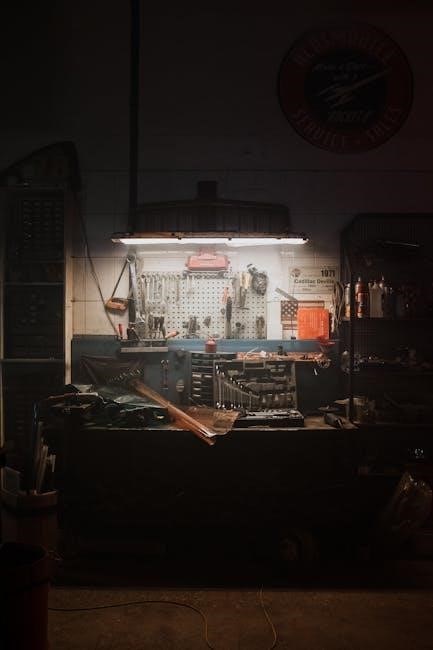
A screw is an essential fastening device with helical threads, designed to join materials or transmit force․ Its versatility makes it indispensable in construction, manufacturing, and everyday applications․
1․1 Definition and Basic Function
A screw is a cylindrical fastener with helical threads, designed to join materials or transmit force․ It operates by converting rotational torque into linear force, enabling secure connections between objects․ The basic function involves inserting the threaded shank into a material or pre-threaded hole, then turning the head to create a tight bond․ Screws are fundamental in construction, machinery, and everyday applications due to their versatility and reliability in holding components together․ Their design ensures strength and stability across various tasks․
1․2 Historical Overview
The screw’s origins trace back to ancient civilizations, with early versions like the Archimedes’ screw used for irrigation․ By the Middle Ages, screws appeared in wine presses and olive oil extraction․ The Industrial Revolution brought mass production, standardizing screws for machinery and construction․ Historical applications laid the groundwork for modern screw technology, emphasizing their versatility and widespread use across industries․ This evolution highlights the screw’s enduring importance as a fundamental engineering component․
Types of Screws
Screws are classified into various types, including wood, machine, self-tapping, drywall, and concrete screws, each designed for specific applications and materials․
2․1 Wood Screws
Wood screws are specifically designed for woodworking, featuring a non-threaded shank above the threads to prevent splitting the wood․ They have a sharp point and coarse threads for strong grip․ Available in various lengths and types, such as self-countersinking screws, they are ideal for furniture, decking, and construction projects․ Their unique design ensures secure fastening without damaging the material, making them essential for woodworking applications․
2․2 Machine Screws
Machine screws are versatile fasteners designed for securing machine parts and components․ They typically require a pre-tapped hole and are often used with nuts for added security․ Available in various drive types, such as Phillips or hex, machine screws offer precise threading for a secure fit․ Commonly used in industrial machinery, electronics, and automotive applications, they are durable and reliable, making them a cornerstone in mechanical assemblies and repairs․
2․3 Self-Tapping Screws
Self-tapping screws are designed to drill their own holes, eliminating the need for pre-drilling․ They are ideal for materials like metal, plastic, and wood․ These screws feature a specialized tip that cuts threads as they are driven in, creating a secure hold․ Common types include sheet metal screws and plastic screws․ They are widely used in applications such as appliance assembly, electronics, and automotive repairs, offering convenience and efficiency in fastening processes․
2․4 Drywall Screws
Drywall screws are specifically designed for securing drywall sheets to wooden or metal studs․ They feature a bugle head, coarse threads, and a sharp point to prevent tear-through․ These screws are typically coated with a rust-resistant finish․ Fine-thread drywall screws are used with metal studs, while coarse-thread versions are for wood․ They are essential for smooth, durable wall installations, ensuring a secure hold and a professional finish in construction and renovation projects․
2․5 Concrete Screws
Concrete screws are heavy-duty fasteners designed for anchoring materials to concrete, brick, or block surfaces․ They feature deep, aggressive threads for a secure hold and often have a sharp tip for easier insertion․ Typically coated for corrosion resistance, these screws are ideal for applications requiring strong anchorage, such as fastening brackets, shelves, or supports to concrete slabs or walls․ Their robust design ensures long-lasting stability in demanding environments․

Screw Components
Screws consist of a head, shank, and thread․ The head provides torque application, while the shank and thread ensure secure fastening․ Tips vary for specific materials․
3․1 Head Types
Screw heads vary in shape and function․ Flat-head screws sit flush with surfaces, while bugle-head screws are designed for drywall․ Oval-head screws are decorative, and pan-head screws are rounded․ Each type serves specific applications, ensuring secure fastening and aesthetic appeal․ Proper head selection is crucial for functionality and design․ Understanding head types helps in choosing the right screw for any project, ensuring strength and durability․ The design of the head also influences torque application and tool compatibility․
3․2 Shank and Thread
The shank is the unthreaded portion of a screw, providing a smooth section for insertion․ The thread, a helical ridge, engages material to create a secure hold․ Thread pitch and depth vary for different materials, ensuring optimal grip․ Coarse threads are used for softer materials like wood, while fine threads suit harder surfaces․ The shank and thread design together determine the screw’s effectiveness, making them critical for load-bearing applications and ensuring durability in various conditions․ Proper thread selection enhances performance and prevents material damage․
3․3 Tip Designs
Screw tips are designed for specific tasks, enhancing functionality․ Sharp tips pierce soft materials like wood, reducing splitting․ Flat tips are ideal for countersinking, ensuring a flush finish․ Notched tips provide better grip, preventing slippage․ Rounded tips minimize material damage, while self-tapping tips create their own threads․ Each design addresses unique challenges, ensuring screws perform optimally in various applications, from construction to electronics․ Proper tip selection ensures efficiency, durability, and ease of use across different materials and projects․ Tips are tailored to meet precise fastening needs, making screws versatile tools for diverse industries and tasks․
Screw Drives and Heads
Screw drives and heads are designed to optimize torque transfer and provide secure fastening․ Common drive types include Phillips, flathead, and Torx, while heads vary from flat to round or hexagonal, offering versatility for different applications and materials․
4․1 Common Drive Types
Common screw drives include Phillips, flathead, Torx, hex (Allen), and square (Robertson)․ These designs provide optimal torque transfer and prevent cam-out․ Phillips and flathead are widely used, while Torx and hex drives are favored in specialized applications․ Square drives are common in construction․ Each type minimizes slipping, enhancing control during fastening, and suits specific materials and tasks for reliable performance across various industries․
4․2 Countersinking and Flush Mounting
Countersinking involves drilling a cone-shaped hole to accommodate a screw head, allowing it to sit flush․ Flush mounting ensures the screw head is level with the surface, enhancing aesthetics and safety․ This technique is critical in woodworking and metalwork to prevent protrusions․ Specialized bits create precise countersinks, while self-countersinking screws simplify the process․ Proper alignment and tooling ensure a seamless finish, reducing the risk of damage or uneven surfaces in construction and assembly․

Fastening Mechanisms
Screws mechanically join materials by engaging threads, providing a secure connection․ Torque applied to the head tightens the screw, ensuring a firm and reliable bond between components․
5․1 Threaded Fasteners
Threaded fasteners, like screws, create secure connections by engaging complementary threads in a mating part․ They are commonly used with nuts or directly in threaded holes․ Machine screws and set screws are examples, providing axial clamping force when tightened․ The thread design ensures resistance to loosening and distributes load effectively, making them reliable in various applications․ Proper torque application is critical to achieve the desired clamping force without damaging the threads․
5․2 Clamping Force
Clamping force is the axial load exerted by a screw to maintain joint integrity․ It prevents movement and ensures structural stability․ The force depends on screw type, thread design, and torque applied․ Proper clamping force is critical to avoid loosening over time․ Excessive force can damage materials, while insufficient force may lead to joint failure․ Balancing clamping force ensures reliability and safety in applications, making it a key factor in fastening mechanisms․
Mechanical Advantage
Screws function as simple machines, converting rotational force into linear motion․ This mechanical advantage enables efficient lifting of heavy loads and precise adjustments with minimal effort applied․
6․1 Simple Machines
Screws are classified as simple machines, part of the six classical types․ They convert rotational force into linear motion, providing mechanical advantage․ This principle allows screws to lift heavy loads, adjust positions, or secure materials efficiently․ Their helical design translates torque into movement, making them fundamental components in machinery and mechanisms․ Screws exemplify how simple machines enable complex tasks through basic mechanical principles, highlighting their essential role in engineering and everyday applications․
6․2 Leverage and Efficiency
Screws utilize leverage to amplify applied force, enhancing efficiency in various applications․ Their helical threads and precise engineering reduce friction and wear․ By converting rotational force into linear motion, screws enable precise control and minimize energy loss․ This makes them ideal for heavy-duty machinery, precision engineering, and high-speed operations where efficiency is critical․ Their design ensures optimal performance, balancing strength and ease of use across diverse industries and tasks․

Common Uses
Screws are widely used in construction, furniture assembly, and electronics․ They secure materials like wood, metal, and drywall, providing strength and stability in various applications․
7․1 Construction Applications
Screws are indispensable in construction, offering versatility across various materials․ Wood screws are ideal for framing and decking, ensuring strong joints․ Drywall screws create smooth finishes, countersinking for flush mounting, while concrete screws anchor heavy structures securely․ Self-tapping screws simplify installation in metal studs, enhancing efficiency․ Their ability to provide consistent clamping force and resistance makes them essential for durable and safe building projects, ensuring stability and longevity in construction․
7․2 Industrial Machinery
Screws play a pivotal role in industrial machinery, enabling precise movement and heavy load management․ Ball screws, with internal ball bearings, minimize friction for high-speed, high-precision applications․ They are integral to CNC machines and robotic systems, ensuring smooth operation․ Machine screws are used extensively for assembling components, while self-tapping screws simplify installation in metal frameworks․ Their durability and ability to maintain clamping force make screws essential for reliable performance in demanding industrial environments, driving efficiency and productivity․

Safety Tips
Always handle screws with care to avoid injuries․ Use proper tools to prevent stripping heads․ Ensure screws are tightly secured to avoid loosening over time and potential accidents․
8․1 Handling Precautions
When handling screws, wear gloves to prevent cuts and ensure a firm grip․ Use appropriate tools to avoid slippage and potential injury․ Keep work areas clean and well-lit to minimize accidents․ Avoid over-tightening, as this can damage materials or strip threads․ Handle small screws carefully to prevent them from being lost or misplaced․ Never use damaged or corroded screws, as they may fail under stress․ Store screws in a dry, organized space to maintain their quality and safety for future use․
8․2 Proper Tool Usage
Using the correct tools is crucial for safe and effective screw handling․ Always match the screwdriver or wrench to the screw head type to avoid slippage and damage․ For manual driving, use screwdrivers with insulated handles to prevent shock․ Power tools should be set to appropriate torque levels to avoid stripping threads․ Regularly maintain tools to ensure proper function․ Store tools in a clean, dry place to prevent rust and wear․ Proper tool usage enhances safety and ensures secure fastening․
Future Trends
Future screws will feature advanced materials like high-strength alloys and smart technology, integrating sensors for real-time monitoring․ Innovations aim to enhance durability, efficiency, and adaptability across industries․
9․1 Material Innovations
Future screw designs will leverage advanced materials like high-strength alloys, lightweight metals, and advanced polymers․ These innovations aim to enhance durability, corrosion resistance, and weight reduction․ Researchers are also exploring eco-friendly materials, such as biodegradable polymers, to align with sustainability goals․ Additionally, smart materials that adapt to environmental conditions, like temperature or stress, are being developed to improve performance in extreme applications․ These advancements promise to revolutionize industries by offering superior fastening solutions․
9․2 Smart Screw Technology
Smart screw technology integrates sensors and IoT connectivity to monitor tension, temperature, and wear in real time․ These screws can alert systems of potential failures, reducing downtime․ Advanced materials and coatings enhance durability, while self-tightening mechanisms maintain secure connections․ Innovations like energy-harvesting screws, which power themselves, are also emerging․ These intelligent fasteners are transforming industries by improving safety, efficiency, and maintenance processes, offering a glimpse into a future where screws adapt and respond to their environments dynamically․
Leave a Reply
You must be logged in to post a comment.